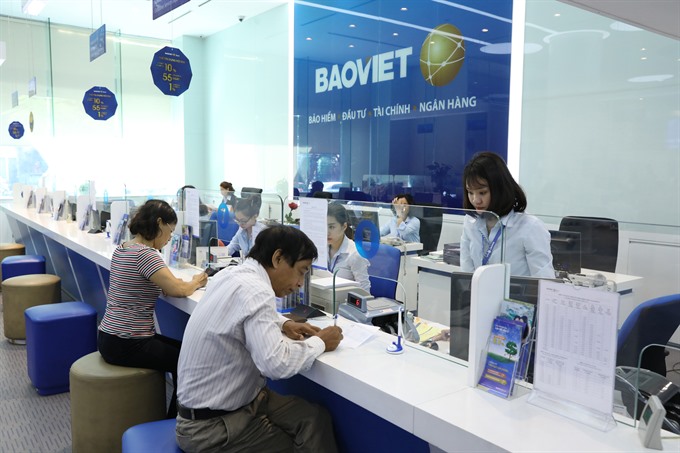 Economy
Economy

The State Bank of Việt Nam (SBV) has said it would continue allocating credit growth limits for commercial bank this year to match the 14 per cent growth target set for the entire banking sector.
 |
| Giao dịch tại ngân hàng Bảo Việt tại 72 Trần Hưng Đạo Hà Nội - VNS Photo Trương Vị |
HÀ NỘI – The State Bank of Việt Nam (SBV) has said it would continue allocating credit growth limits for commercial banks this year to match the 14 per cent growth target set for the entire banking sector.
SBV Governor Lê Minh Hưng said the credit growth target set for this year was equivalent to the rate in 2018 so growth quotas would be assigned on the basis of assessing the operation and ability to develop credit healthily at each bank.
The SBV often sets credit growth limits for commercial banks, and most banks are expecting higher quotas this year as their profits depend significantly on lending services.
According to Lê Đức Thọ, chairman of VietinBank, his bank needs a higher credit growth quota this year to meet the demands of borrowers, especially for large national projects.
Last year, the SBV allowed VietinBank a credit growth limit of only 6.1 per cent, causing the bank’s pre-tax profit to drop to VNĐ6.8 trillion (US$291.85 million) in 2018.
Banks that are restructuring also expect to have expanded credit growth limits in 2019.
Dương Công Minh, chairman of Saigon Thuong Tin Commercial Joint Stock Bank (Sacombank), asked the SBV for a credit growth limit of 18-20 per cent for his bank for 2018-20 period, the rate for which in 2019 would be 19 per cent.
Similarly, the HCM City Development Commercial Joint Stock Bank (HDBank) also expects to have a higher credit growth limit this year as it is in the process of completing a merger with Petrolimex Group Commercial Joint Stock Bank (PGBank).
Nguyễn Xuân Thành, director of the Public Policy Programme at the Fulbright School in HCM City, said the allocation of credit growth limits based on each bank’s health was appropriate as the pressure on credit growth in the banking industry was currently not significant.
Other experts also said the central bank should cautiously consider any expansion of credit growth limits for banks because it would carry risks, explaining if credit growth allocation was not strictly controlled, it would affect credit quality and cause bad debt to increase sharply.
Cấn Văn Lực, chief economist at the Bank for Investment and Development of Vietnam, said banks shouldn’t expand lending unless they could manage the risks to ensure sustainable development.
In a recent report, Moody’s Investors Service also said moderation in Vietnamese banks’ credit growth was positive for their asset quality and capitalisation, explaining lower credit growth encouraged banks to focus on better quality borrowers, which would improve asset quality in the long term.
Experts forecast the central bank would continue control credit growth at around 14 per cent per year in the next three to five years, lower than the average rate of 18.1 per cent in the 2015-17 period.
SBV data showed Vietnamese banks’ total credit grew 14 per cent in 2018, the lowest growth rate since 2014. The slower growth was primarily due to the central bank’s tightening of credit growth limits. — VNS




